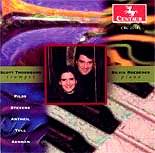AVAILABILITY
www.centaurrecords.com
The repertoire of music for trumpet and piano
is not exactly enormous and the only composer you are likely to
know here is the "bad boy of music", George Antheil.
The name of Halsey Stevens may ring a bell since he is the author
of a widely appreciated book on Bartók. John Wallace recently
got round the repertoire problem by playing Brahmsí Clarinet Sonatas
on the trumpet, remarkably successfully at times though it would
take a strange listener to prefer the trumpet versions to the
originals. Little known composers are not, of course, by definition
bad ones, and Scott Thornburgís recital succeeds in showing that
the 20th Century produced a certain corpus of worthwhile original
music for this combination.
The odd man out among all these Americans is
the Viennese Karl Pliss. His combination of an effusive Richard
Strauss-influenced style with some quirky Debussyian harmonies
sets him among such contemporaries as Schreker or Gál.
A true dialogue between the partners, this is a rewarding, passionate
work which must be very satisfying to play.
Central European influences are at work, too,
in Halsey Stevensís Sonata. To tell the truth I donít hear the
Bartók influence of which Sylvia Roederer speaks in her
useful booklet notes. The American accent seems to me to predominate,
with more of Coplandís wide, open spaces than of the Hungarian
plains.
By 1951 George Antheil had long put behind him
such wild oats as the Ballet mécanique (1925) to write
in an engagingly fresh style which suggests French influences
(Antheil lived in France for some years). Hearing the work blind
I think this sonataís charming brand of wrong-note Fauré
would have suggested Milhaud to me. This was, for me, the pick
of the five works.
Fisher Tullís Bagatelles are expertly written
(the whisper mute is hauntingly effective in the second piece).
They are perhaps more in the "useful addition to the repertoire"
category than greatly memorable. The same may be said of Kent
Kennanís Sonata which, according to Silvia Roederer, "holds
a well-deserved place as a standard in the trumpet and piano repertoire".
Not on the European side of the Atlantic Ocean, thus far, but
it may yet do so since it is the sort of well laid-out modern-academic
piece that should go down well with audiences.
Performances and recordings are beyond praise;
for brass enthusiasts I need say no more. Non-specialists may
be glad to have a trumpet and piano disc on their shelves will
surely enjoy getting to know the Pliss and the Antheil sonatas.
Christopher Howell

